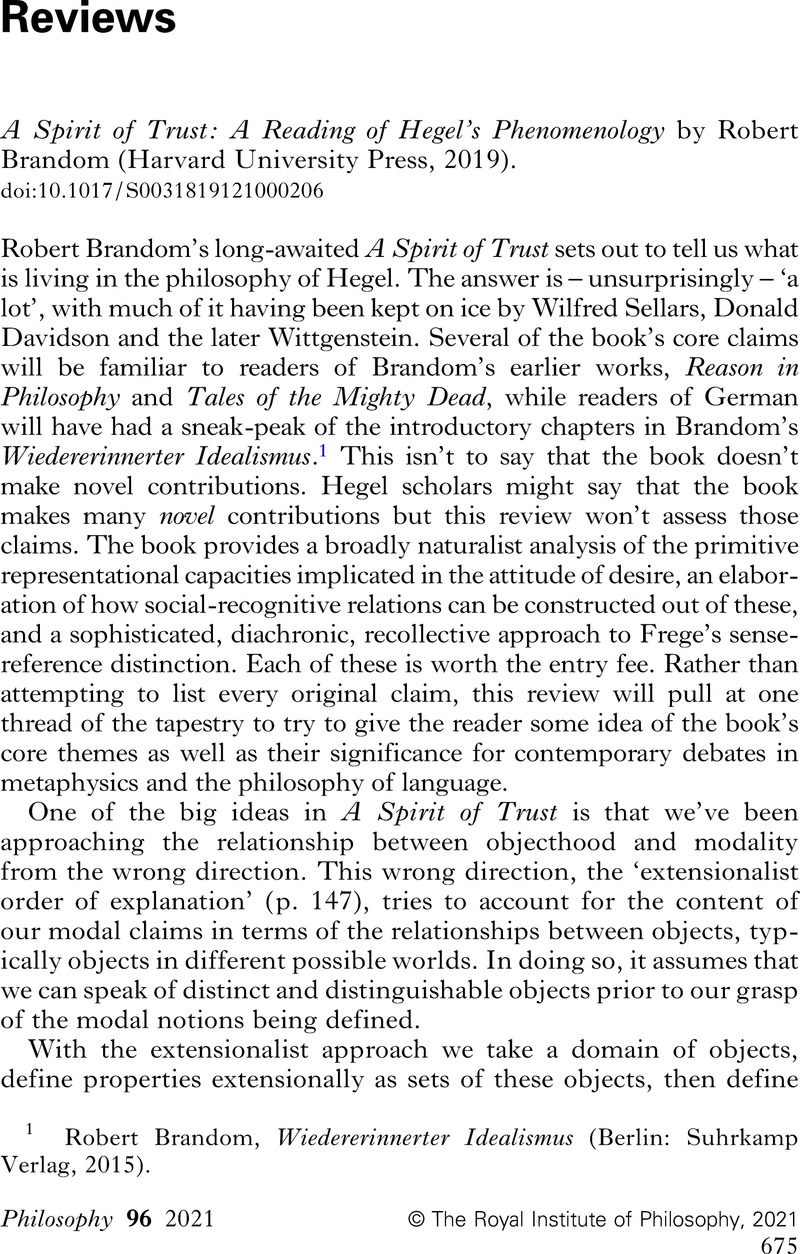No CrossRef data available.
Article contents
A Spirit of Trust: A Reading of Hegel's Phenomenology by Robert Brandom (Harvard University Press, 2019).
Published online by Cambridge University Press: 10 June 2021
Abstract

- Type
- Review
- Information
- Copyright
- Copyright © The Royal Institute of Philosophy, 2021
References
1 Brandom, Robert, Wiedererinnerter Idealismus (Berlin: Suhrkamp Verlag, 2015)Google Scholar.
2 Van Orman Quine, Willard, ‘On What There Is’ The Review of Metaphysics, Vol. 2, No. 5 (1948) p. 23Google Scholar.
3 Williamson, Timothy, Modal Logic as Metaphysics (Oxford: Oxford University Press, 2013)CrossRefGoogle Scholar.
4 Shannon, Claude E. and Weaver, Warren, The Mathematical Theory of Communication (Urbana: University of Illinois Press, 1949)Google Scholar.
5 For a helpful overview of the apoha theory, see the papers in Siderits, Mark, Tillemans, Tom, Chakrabarti, Arindam (eds.), Apoha: Buddhist Nominalism and Human Cognition, (New York: Columbia University Press, 2011)Google Scholar.
6 Strawson, Peter Frederick, The Bounds of Sense: An Essay on Kant's Critique of Pure Reason (New York: Routledge: 2018 [1966]), p. 49Google Scholar.
7 Consider the arch-extensionalists Tarski and Quine. Tarski took it as a criterion for the intelligibility of a language that its variables only range over physical objects (see Frost-Arnold, Greg, ‘Tarski's Nominalism’ in Patterson, D., (Ed.) New Essays on Tarski (New York and Oxford: Oxford University Press, 2008)Google Scholar. Quine's ontology was confined to sets and physical objects with the latter understood as the contents of portions of space-time. He also took ostension and identity to be sufficient for our understanding of the concept of ‘object’ without the need to invoke any modal notions (Van Orman Quine, Willard, Theories and Things (Cambridge, MA: Harvard University Press, 1981)Google Scholar).
8 Brandom, Robert, Making it Explicit (Cambridge MA: Harvard University Press, 1994), p. 458Google Scholar.
9 Strawson, Peter Frederick, Individuals (London: Methuen, 1959), p. 214Google Scholar.
10 One of the most intriguing proposals is that we should consider the relation between sense and reference in diachronic, expressive terms. Traditional Fregean senses determine sharp and complete sets (p. 429). As denizens of a third immaterial realm, they can be fixed for all time, unchanging and determinate. Brandom proposes that we should think instead in terms of Hegelian senses which are constantly in a process of being determined by our epistemic practices. The distinction between sense and reference shows itself in our experience when we distinguish how things are and how we took them to be. Reference is what things were all along — what was implicit. This distinction is a product of treating our conceptual relations as normatively binding (p. 428).
11 I would like to thank Matt Soteriou, Mark Textor, Jørgen Dyrstad and John Callanan for helpful discussion about some of the material here.





